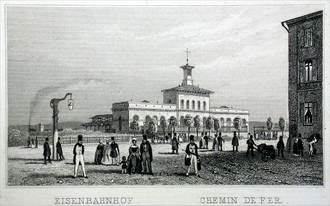Wiesbaden Taunusbahnhof

Wiesbaden Taunusbahnhof is a former and abandoned station of the Taunus Railway in Wiesbaden , built in the 1840s .
Geographical location
The terminus station was on the corner of Rheinstrasse and Wilhelmstrasse and was the beginning and end of the Taunus Railway , which connected Wiesbaden with Frankfurt am Main . This made it the counterpart to Frankfurt's Taunusbahnhof at the other end of the line.
Reception building
The reception building came - like all the other buildings along the route - from the Mainz architect Ignaz victims man . It was very similar to its Frankfurt counterpart at the other end of the route, but was a bit smaller: the pavilions at the end of the wing structures were dispensed with here. A clock tower stood on the two-storey central building. The reception hall and ticket office were in the center, waiting rooms and baggage handling in the wings.
In the reception building, the equipment soon proved to be no longer able to cope with the rapidly increasing traffic. Points of criticism were the unkempt environment, an industrial area, which was inappropriate for a spa town, and that a prince's room was missing. At state receptions the unpaved station forecourt and a visually dominant goods hall were a nuisance. It was not until 1897 that the city of Wiesbaden built a small extension to the reception building as a prince's room, which was only closed off with a curtain from the platform .
history
The Taunusbahnhof was the first train station in the then Nassau capital Wiesbaden . The opening took place together with the last section of the Taunus Railway on March 10, 1840. Scheduled operations between Wiesbaden and Frankfurt began on April 13, 1840. When it opened just 4½ years after the first German line from Nuremberg to Fürth in 1835, it was one of the pioneers of German railway stations. However, this was soon noticed because of the rapidly growing traffic, so that it was criticized that it was too small. It was improvised until the station was finally replaced in 1906 by the new main station , which was located about 800 meters further south - at that time on the edge of the city. The old railway systems were demolished.
With the opening of the new main station on November 15, 1906, the Taunusbahnhof was closed. The Wiesbadener Tagblatt didn't leave the old train station in good shape and wrote:
“He was never a beauty; he had always renounced any cosmopolitan elegance; it was a disappointment for anyone who, from this side, set foot for the first time in the famous spa town that had been lifted a thousand times into the sky. [...] In the end, he would have been simply an embarrassment for Wiesbaden if his old age did not excuse him and if the excellent circumstance that one was dealing with a veteran of the first German railroad era wasn't a little to his and a highly commendable railroad authority Would have spoken in favor ... "
In 1910 Wilhelmstrasse was extended southwards to the Ringstrasse and the new central station in the form of a wide avenue under the name Kaiserstrasse (today: " Friedrich-Ebert-Allee "). Unlike in Frankfurt, a densely built-up residential area ( Bahnhofsviertel ) was not built on the former track system , but from 1913 a public green area ( Reisinger systems and Herbert systems ). The Rhein-Main-Halle was opened in 1957 on the site of the station head of the Taunusbahnhof and - in a later extension in 1969 of the neighboring Rheinbahnhof .
Surroundings
Two more terminal stations were built in the immediate vicinity: the Rheinbahnhof as the terminus of the Nassau Rheinbahn via Rüdesheim am Rhein to Oberlahnstein (1857; however, the building was not put into operation until October 1, 1866) and the Ludwigsbahnhof as the terminus of the Hessian Ludwigsbahn via Niedernhausen (today : Ländchesbahn ) and on to Limburg an der Lahn .
See also
literature
- Railway in Hessen. Cultural monuments in Hessen. Monument topography Federal Republic of Germany . Edited by the State Office for Monument Preservation Hessen. Theiss Verlag, Stuttgart 2005, 3 volumes in a slipcase, vol. 2.1, p. 19ff (series 001). ISBN 3-8062-1917-6
- Gottfried Kiesow : Architectural Guide Wiesbaden - The City of Historicism . German Foundation for Monument Protection, Bonn 2006, ISBN 3-936942-71-4
Individual evidence
- ↑ Silvia Speckert: Ignaz Opfermann (1799–1866): Selected examples of his construction activity in the vicinity of the city of Mainz = housework to obtain the academic degree of a Magister [!] Artium. Johannes Gutenberg University Mainz 1989. Typed. Volume 1: Text, Volume 2: Tables. Mainz City Archives: 1991/25 No. 11, p. 69.
- ↑ Bernd-Michael Neese: The emperor is coming. Wilhelm I and Wilhelm II in Wiesbaden . Wiesbaden 2010. ISBN 978-3-928085-55-7 , pp. 82-85.
- ^ Website of the Odenwaldbahn
- ↑ Eisenbahndirektion Mainz (ed.): Official Gazette of the Royal Prussian and Grand Ducal Hessian Railway Directorate in Mainz of November 10, 1906, No. 59. Announcement No. 615, p. 505.
- ^ Report in the Wiesbadener Kurier from November 15, 2006
- ↑ Kiesow, p. 194 f
- ↑ Kiesow, p. 84
- ^ Website of the ESWE Verkehrsgesellschaft ( Memento of the original from October 16, 2006 in the Internet Archive ) Info: The archive link was automatically inserted and not yet checked. Please check the original and archive link according to the instructions and then remove this notice.
- ^ The Wiesbaden city train station, 1875. Historical photo documents from Hesse. In: Landesgeschichtliches Informationssystem Hessen (LAGIS).
Coordinates: 50 ° 4 ′ 39 " N , 8 ° 14 ′ 41.3" E




